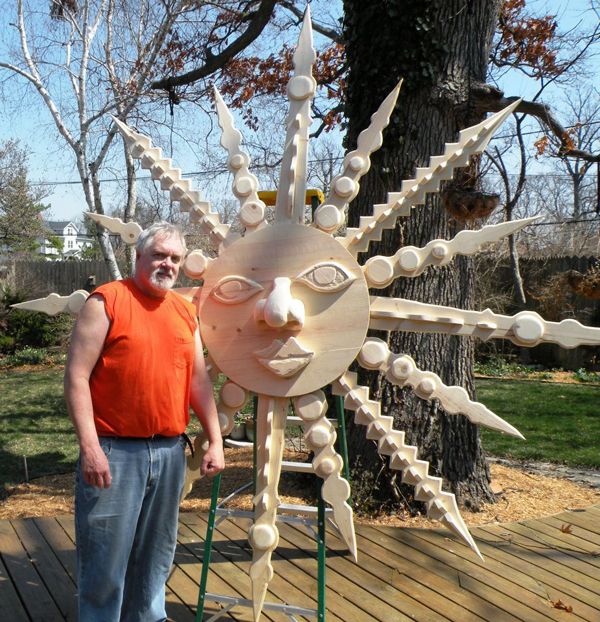Thousands of colorful dots wrap the surface of a unique sculpture, entitled “Sun Kissed,” that rises above the heads of staff and students at Homestead High School. Artist and teacher Mike Schmid quietly inspires those who come face to face with his work. “Sun Kissed,” a gleeful sun icon that spans 9.5 feet, debuted at the international art competition Artprize held annually in Grand Rapids, Michigan. Inspired by the vibrant energy of the competition, Schmid decided to take on a grand-scale project. Each piece of “Sun Kissed” was carved from pine, then sanded and covered with a black primer to enhance the painted gold overlay. After assembling nearly 20 individual pieces, Schmid painstakingly stippled the entire surface of the sculpture with every color imaginable. Schmid spent over 50 hours on the impressive undertaking that now shines above the art department where he works. It is within these halls that he strives to accomplish his greatest work: inspiring young artists to think big and tackle any goal their active brains may dream of. Schmid is an artist fueled by the exhilaration of a new idea. He feeds off of the energy of his students and is quick to return their creative vibes with encouragement and coaching. Schmid may not remember the name of his most influential teacher, but he will never forget her flowing red hair, spiked heels and leather pants. He has fond memories of Ms. Amazing Teacher and how she fostered his fascination for all things curious in the art world. She planted a seed in Schmid’s mind that has grown to take on a life of its own. In return, Schmid has cultivated a new crop of young, inspired artists.
Schmid started his career teaching in an elementary school. After spending 27 years surrounded by tiny hands covered with paint and glue, Schmid took a giant leap. He dove headfirst into the world of sprouting facial hair, date drama and roller-coaster emotions. For the past eight years, Schmid has been serving the students of Homestead High School where he has had the pleasure to work with many of his former elementary students.
Schmid is about to make another career change. In just a few weeks, his time with high school students will end and a new opportunity as a middle school art teacher will begin. So far his ride on the educational roller-coaster has been “spectacular,” and I would guess he has big plans for this next set of curves.
Schmid says of his teaching career, “I don’t know what I would do with out teaching. Kids bring out the whole energy of life. I’ve seen kids become incredible people. Working with them is rewarding as a teacher, artist and as a person.”
Schmid is an artist who teaches, yet he says, “Making art is secondary to teaching.” In actuality, Schmid views the world with an artist’s brain. He considers his own students as the media he uses to explore the ideas and artistic concepts that spin and churn inside his head. He is a perpetual thinker and strives to come up with new ways to challenge both his students and himself. Schmid recently merged his own artistic development with his students’ when he presented his class with a project that challenged them to create paper pulp casts.
Schmid followed along, creating his own work in pulp as his students worked beside him. He has long been inspired by ethnic cultures and recently began to develop an idea that he has carried in his mind for years. He created a series of paper pulp casts depicting an aboriginal Dreamtime folk tale about cranes and the rise and fall of the sun. The casts illustrate the story with an elegantly designed crane that discovers a koi as it searches for food in the tall grasses surrounding a swamp. The story continues with the crane pulling the fish up in its long, slender beak. As it rises up from the water, the fish’s scales begin to shine. The crane stretches its thin neck, preparing to gulp its lunch, but the koi rises into the sky and becomes the sun. Schmid hopes to one day write the text and publish the entire series of paper sculptures in the form of a children’s picture book.
Schmid discovered his love of art when he was a child. He grew up in North Muskegon, Michigan where he and his older sister set up a primitive studio in their basement using familiar childhood construction materials including blankets, pillows and rugs. Inside his blanket-fort, Schmid remembers creating his first subtractive sculpture carved from plaster formed in a cardboard milk carton. He and his sister picked and scraped, creating a stylized blob of plaster that Schmid still has today.
Schmid went on to attend Michigan State University where he learned to combine two- and three-dimensional techniques. He once tried to create a three-dimensional project that appeared to be flat, challenging himself to remove all shadows and contrast. The project was a self-proclaimed failure but he nonetheless learned a great deal.
Schmid’s no-fear attitude has given him the strength needed to forge new territory in the community. He has found opportunities to bring art to wider circles of participants by founding two nonprofit organizations. Schmid came up with the idea to establish FAME, the Foundation for Art and Music in Education, when he realized art and music teachers often led isolated careers. The idea was to offer educators an opportunity to network and bounce ideas off of one another. FAME just celebrated its 26th year and reaches over 10,000 students in northeast Indiana every year. Schmid was also a key player in the development of Camp Whatcha Wanna-Do, a camp that was first established to bring the arts to young people dealing with cancer. The camp is currently planning for its 21st summer session.
Constantly thinking of ways to bring art to his community and simply brighten the lives of as many people as he can, Schmid’s work as an artist often flows off of the canvas. Creative acts, as seemingly simple as planting thousands of daffodils throughout his neighborhood, are common for Schmid. He is a man who not only conceives ideas, but he is willing to do the work necessary to pull them off.
He works hard to develop a positive environment wherever he goes, which could be in a classroom, throughout his community or within the pages of an inspiring children’s book. Schmid is a living example of so many characters in children’s literature who, along their journey, plant seeds that sprout into apple trees or lupines, all for the sake of making the world a better place. In Schmid’s case, his art and passion are planting seeds in the minds of our youth. His body of work is a collection from which we will all benefit.


